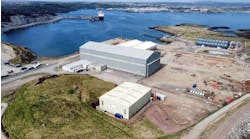At a time of record inflation, sky-high energy costs, and global uncertainty, it is critical that the Biden administration move forward with developing a new federal offshore oil and gas leasing program.
Prices continue to rise across the board, and consumers are afraid that federal policies are not doing enough to counter rampant inflation. Consumer sentiment is at its lowest level since the aftermath of the Great Recession. Families are rightly concerned about their household finances and well-being. This outlook could worsen, as groups such as Goldman Sachs are predicting inflation to increase further this year.
Energy prices have been a key driver of inflation. The cost of energy rose 27% over the past year, according to the Bureau of Labor Statistics, while the top-line inflation rate was “only” 7.5%.
While the rise in inflation, including in energy prices, began before the Ukraine-Russia conflict ignited, the conflict in Eastern Europe exacerbated global uncertainty and caused massive increases in energy prices. The conflict triggered Brent crude futures crossing the $100 per barrel mark for the first time since 2015, reaching nearly $140 per barrel at one point.
Complicating the world’s response to Russia is that Europe still needs foreign energy, and depends on Russia to get it. Russia is the main EU supplier of crude oil, natural gas and solid fossil fuels. In 2019, Russia accounted for close to 27% of EU imports of crude oil and 41% of EU natural gas imports. It is important to note that even in 2020, the US imported 540,000 barrels of oil per day from Russia, up from 370,000 barrels per day in 2015. Imports from Russia into the United States hit a record high in June of 2021.
As some US Senators are calling on the White House to ban crude oil imports from Russia, every policymaker should embrace the strategically fundamental step of producing more American energy. Every barrel of oil produced in the US Gulf of Mexico is a barrel that America and our allies do not have to source from countries like Russia; and that production helps stabilize energy markets with responsibly produced energy.
Unfortunately, the federal policies that support continued oil and gas production in the US Gulf of Mexico oil and gas production have been called into question.
Last summer, a court confirmed that the federal government has a legal obligation to maintain and hold offshore oil and gas lease sales, including the obligation to promulgate leasing schedules. That ruling also blocked the federal “pause” of new oil and gas leasing.
Federal offshore leasing resumed last November with Lease Sale 257. With bids on 308 lease blocks and a high bid total of about $191 million, the lease sale showed a high level of interest from producers and demonstrated an enduring belief that the US Gulf of Mexico remains a premier, lower-carbon energy producing basin.
However, activists immediately sued the Department of the Interior over the lease sale, saying it ran counter to the administration’s stated goals of transitioning toward cleaner energy. The US District Court for the District of Columbia eventually vacated the Record of Decision for the lease sale.
While the Lease Sale 257 ruling is being appealed, the expiration of the current federal offshore leasing program this summer looms over the Gulf of Mexico E&P market. The current US offshore oil and gas leasing plan expires June 30, 2022, and the status of the next five-year leasing program is unknown. Under law and unless otherwise prescribed, lease sales can only proceed if they are included in a formally finalized five-year leasing program. There will likely be a significant delay of lease schedules while we wait for the next leasing program to be put in place.
The current uncertainty around access to Gulf of Mexico oil and gas reserves casts a long shadow over an otherwise robust, productive, and prospective premiere lower carbon region.
Global energy demand is rising, and experts predict a gap between demand for oil and gas and the production of oil and gas. Worldwide, more than 300 billion barrels of oil from undeveloped and undiscovered resources need to be added to currently producing assets. The world is going to need growing and responsibly produced oil and gas, and the Gulf of Mexico can and should be the region of choice.
The US Gulf of Mexico provides a path to meet emission targets so we can meaningfully address climate change. Gulf of Mexico oil and gas production has a carbon intensity one-half of other oil producing regions. The deepwater region, which represents 92% of Gulf of Mexico production, has the lowest carbon intensity of any oil-producing region. Without production from the Gulf, our country would rely upon supplies from foreign sources with higher emissions profiles, and with increased emissions associated with tanker transport over long distances.
The Gulf of Mexico oil and gas industry is also leveraging its decades of experience to support other emerging offshore energy markets. We are on the heels of a $4.37-billion wind lease sale offshore New York and New Jersey. Three more offshore wind lease sales could occur this year.
The US offshore industry is accelerating carbon capture and storage (CCS) technologies. CCS promises to be a critical tool in reducing carbon emissions from industrial processes, which could be key to reducing global warming. Early projections show that 50 million tons of carbon dioxide annually could be stored beneath the Gulf of Mexico by 2030, more than all the CCUS currently operating globally.
The climate benefits that can be derived from the US offshore industry go hand in hand with other economic and environmental benefits. More than 345,000 high paying and accessible jobs are supported by Gulf of Mexico lease sales. The average offshore project has more than 200 types of jobs directly involved with it. These jobs, on average, have salaries nearly 30% higher than the national average.
Revenues generated from lease sales and from rents and royalties also fund critical federal, state, and local government programs. Revenue sharing with Gulf Coast states helps fund wetland restoration, flood prevention, hurricane mitigation, and other programs. Louisiana Senator Bill Cassidy said: “offshore energy production is vital for efforts to restore and rebuild our coastline.”
The Land & Water Conservation Fund (LWCF) is funded virtually entirely by Gulf of Mexico oil and gas production. The LWCF provides money to protect endangered species habitats, develop parks and outdoor recreation sites and protect sensitive forests and wildernesses.
The LWCF also helps provide funding for urban programs. The Outdoor Recreation Legacy Program builds new parks and improves existing ones in poorer, underserved neighborhoods. The program provides safe havens and oases to communities that need them the most and would not otherwise have funding. More than $30 million has been delegated to 50 communities over the past six years.
For 50 years, the National Ocean Industries Association has been the voice of America’s offshore energy industry. As the world continues to need reliable, responsible, and affordable sources of energy, the US offshore marketplace is a powerful resource to help solve some of the most pressing issues facing society. Whether it is offshore oil and gas, offshore wind, or offshore CCS, the federal government plays a central role in implementing policies that can encourage, or discourage, investment in these projects that enhance our energy security and global competitiveness. NOIA serves as the advocate in Washington, D.C., for the offshore energy industry so that these projects and investments can have the regulatory certainty needed to thrive.
The author
Erik Milito is the president of the National Ocean Industries Association, representing the interests of the offshore oil and gas and wind industries. Mr. Milito has extensive experience in implementing strategic outreach and public relations platforms for high profile issues on behalf of the energy industry. He is a spokesperson and lobbyist for the industry, testifying before Congress and appearing on major news outlets on key energy issues on numerous occasions. Mr. Milito arrived at NOIA in November 2019 after serving for 17 years at the American Petroleum Institute (API), including roles as Vice President, Upstream and Industry Operations and Managing Counsel.




